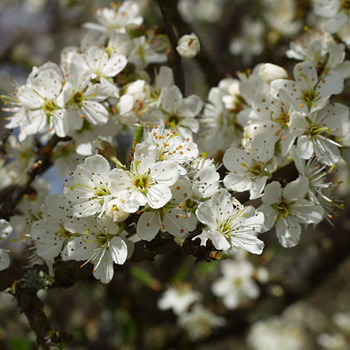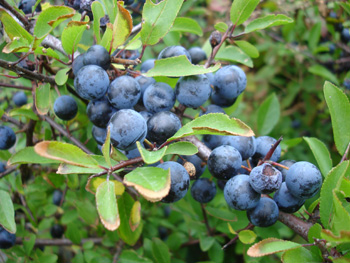Contents:
Common Names | Parts Usually Used | Plant(s) & Culture | Where Found | Medicinal Properties
Uses | Formulas or Dosages | Nutrient Content | Bibliography
Scientific Names

- Prunus spinosa L.
- Rosaceae
- Rose family
Common Names
- Plum
- Sloe
- Sloe plum
- Wild plum
Parts Usually Used
Flowers, fruit, bark of the root
Back to Top

Description of Plant(s) and Culture
Blackthorn is a Eurasian tree or shrub,
Other varieties of plum: Common plum
Back to Top
Where Found
Commonly cultivated for ornamental purposes, grows wild in clearings, among hedges, and along the edges of woods, sunny mountain slopes, on heaths, and in pastures, provided enough lime is present in the soil.
Back to Top

Medicinal Properties
Aperient, astringent, diaphoretic, diuretic, stomachic
Back to Top
Uses
A tea from the flowers is a harmless and reliable purgative and has beneficial effects on the stomach and stimulates appetite. Recommended for mild bladder problems, skin problems, catarrh, stomach cramps, dropsy, and stone formation. Juice of the berries used for inflammations in the mouth and throat. A jam made of the fruit is a palatable laxative safe especially for children. A decoction of the root bark reduces fever.
Also, used to flavor liqueurs and cordials.
Back to Top
Formulas or Dosages
The fruit is more palatable if gathered after going through
Infusion: steep
Back to Top
Nutrient Content

Bibliography
![]() The Herb Book
The Herb Book, by John Lust, Bantam Books, 666 Fifth Avenue, New York, NY. copyright 1974.
![]() Webster’s New World Dictionary
Webster’s New World Dictionary, Third College Edition, Victoria Neufeldt, Editor in Chief, New World Dictionaries: A Division of Simon & Schuster, Inc., 15 Columbus Circle, New York, NY 10023
 The Healing Plants
The Healing Plants, by Mannfried Pahlow, Barron’s Educational Series, Inc. 250 Wireless Blvd., Hauppauge, NY 11788, 1992
